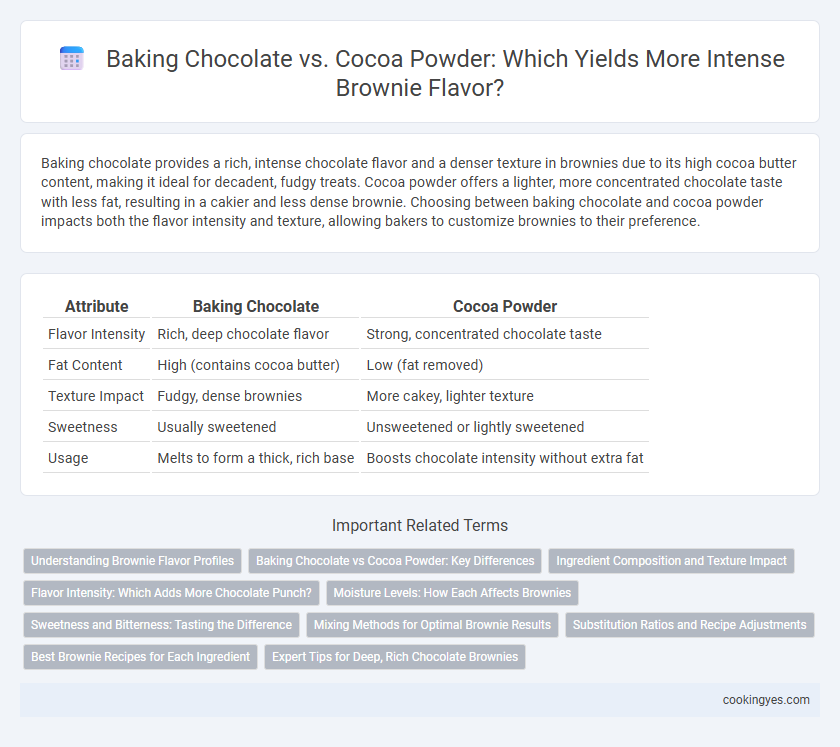Baking chocolate provides a rich, intense chocolate flavor and a denser texture in brownies due to its high cocoa butter content, making it ideal for decadent, fudgy treats. Cocoa powder offers a lighter, more concentrated chocolate taste with less fat, resulting in a cakier and less dense brownie. Choosing between baking chocolate and cocoa powder impacts both the flavor intensity and texture, allowing bakers to customize brownies to their preference.
Table of Comparison
| Attribute | Baking Chocolate | Cocoa Powder |
|---|---|---|
| Flavor Intensity | Rich, deep chocolate flavor | Strong, concentrated chocolate taste |
| Fat Content | High (contains cocoa butter) | Low (fat removed) |
| Texture Impact | Fudgy, dense brownies | More cakey, lighter texture |
| Sweetness | Usually sweetened | Unsweetened or lightly sweetened |
| Usage | Melts to form a thick, rich base | Boosts chocolate intensity without extra fat |
Understanding Brownie Flavor Profiles
Baking chocolate delivers a rich, intense cocoa flavor and a smooth, fudgy texture, making it ideal for dense, decadent brownies. Cocoa powder offers a lighter, more nuanced chocolate taste with a slightly bitter edge, contributing to a drier, cakier brownie consistency. Understanding these distinct flavor profiles helps bakers select the right ingredient to achieve the desired balance between richness and texture in brownie recipes.
Baking Chocolate vs Cocoa Powder: Key Differences
Baking chocolate contains cocoa solids, cocoa butter, and no sugar, providing a rich, intense chocolate flavor and smooth texture, while cocoa powder is pure cocoa solids with most fat removed, offering a lighter, more concentrated chocolate taste with less fat content. Using baking chocolate in brownies yields a fudgy, dense texture due to its fat content, whereas cocoa powder creates a drier, cake-like crumb with a sharper chocolate intensity. The key differences affect moisture, flavor depth, and texture, influencing the final brownie quality based on ingredient choice.
Ingredient Composition and Texture Impact
Baking chocolate contains cocoa solids and cocoa butter, providing a richer, denser texture and deeper chocolate flavor in brownies compared to cocoa powder, which is primarily pure cocoa solids with little to no fat. The fat content in baking chocolate contributes to a fudgier, more moist brownie, while cocoa powder produces a lighter, cakier texture with a slightly more bitter taste. Understanding these ingredient compositions allows bakers to control brownie intensity and texture to achieve the desired final product.
Flavor Intensity: Which Adds More Chocolate Punch?
Baking chocolate delivers a richer, more intense chocolate flavor in brownies compared to cocoa powder, as it contains both cocoa solids and cocoa butter, providing a creamier texture and deeper taste. Cocoa powder, while giving a strong chocolate aroma, offers a slightly lighter flavor and drier consistency due to the absence of cocoa butter. For maximum chocolate punch and fudgy intensity, baking chocolate is the preferred choice.
Moisture Levels: How Each Affects Brownies
Baking chocolate contains cocoa solids and cocoa butter, providing higher fat content that contributes to richer, moister brownies compared to cocoa powder, which lacks fat and results in a drier texture. Cocoa powder absorbs more liquid during baking, often requiring adjustments in recipe moisture to prevent crumbly brownies. Choosing baking chocolate enhances chewiness and a fudgy texture, while cocoa powder emphasizes a more intense chocolate flavor with reduced moisture retention.
Sweetness and Bitterness: Tasting the Difference
Baking chocolate delivers a rich, intense bitterness with minimal sweetness, enhancing the deep cocoa flavors in brownies. Cocoa powder, with its slightly lighter bitterness and subtle natural sweetness, offers a more balanced taste profile, allowing other ingredients like sugar to shine through. Choosing baking chocolate intensifies the cocoa experience, while cocoa powder creates a smoother, milder chocolate flavor in brownies.
Mixing Methods for Optimal Brownie Results
Baking chocolate provides a rich, intense cocoa flavor due to its high cocoa butter content, while cocoa powder offers a more concentrated, slightly bitter taste that intensifies sweetness when balanced correctly. Mixing methods such as melting baking chocolate with butter enhances smoothness and depth, whereas incorporating cocoa powder into dry ingredients promotes even distribution and optimal crumb texture. Achieving optimal brownie results depends on carefully adjusting mixing techniques to suit the chosen chocolate form, maximizing flavor intensity and achieving the desired fudgy or cakey consistency.
Substitution Ratios and Recipe Adjustments
Baking chocolate and cocoa powder differ significantly in fat content and intensity, affecting brownie texture and flavor; typically, 1 ounce of baking chocolate can be substituted with 3 tablespoons of cocoa powder plus 1 tablespoon of fat to maintain moisture. Adjusting sugar levels is crucial since cocoa powder is more concentrated and less sweet than baking chocolate, influencing overall sweetness and bitterness balance. Precise substitution ratios and recipe adjustments ensure optimal brownie density, fudginess, and chocolate depth, enhancing the final dessert quality.
Best Brownie Recipes for Each Ingredient
Baking chocolate and cocoa powder each provide distinct brownie intensity, influencing texture and flavor profiles in best brownie recipes. Baking chocolate delivers a richer, creamier texture with a deep chocolate flavor ideal for fudgy brownies, while cocoa powder yields a lighter, drier crumb with a more pronounced chocolate sharpness perfect for cakey brownies. Selecting the right ingredient depends on desired brownie consistency and intensity, ensuring the best recipe match for flavor depth and texture preference.
Expert Tips for Deep, Rich Chocolate Brownies
Using baking chocolate instead of cocoa powder in brownies intensifies the chocolate flavor by incorporating real cocoa butter, which enhances the richness and texture. Experts recommend melting high-quality unsweetened baking chocolate for a deeper, more velvety taste and smoother crumb. For maximum chocolate intensity, balance the fat content and consider pairing with espresso powder or a pinch of salt to elevate the flavor complexity.
Baking Chocolate vs Cocoa Powder for Brownie Intensity Infographic

 cookingyes.com
cookingyes.com